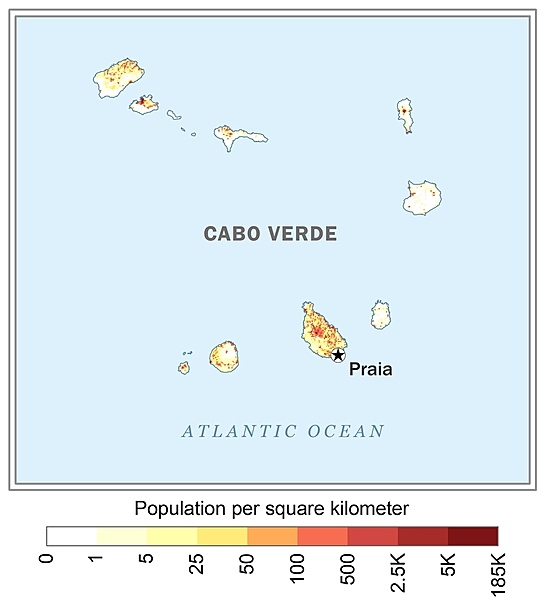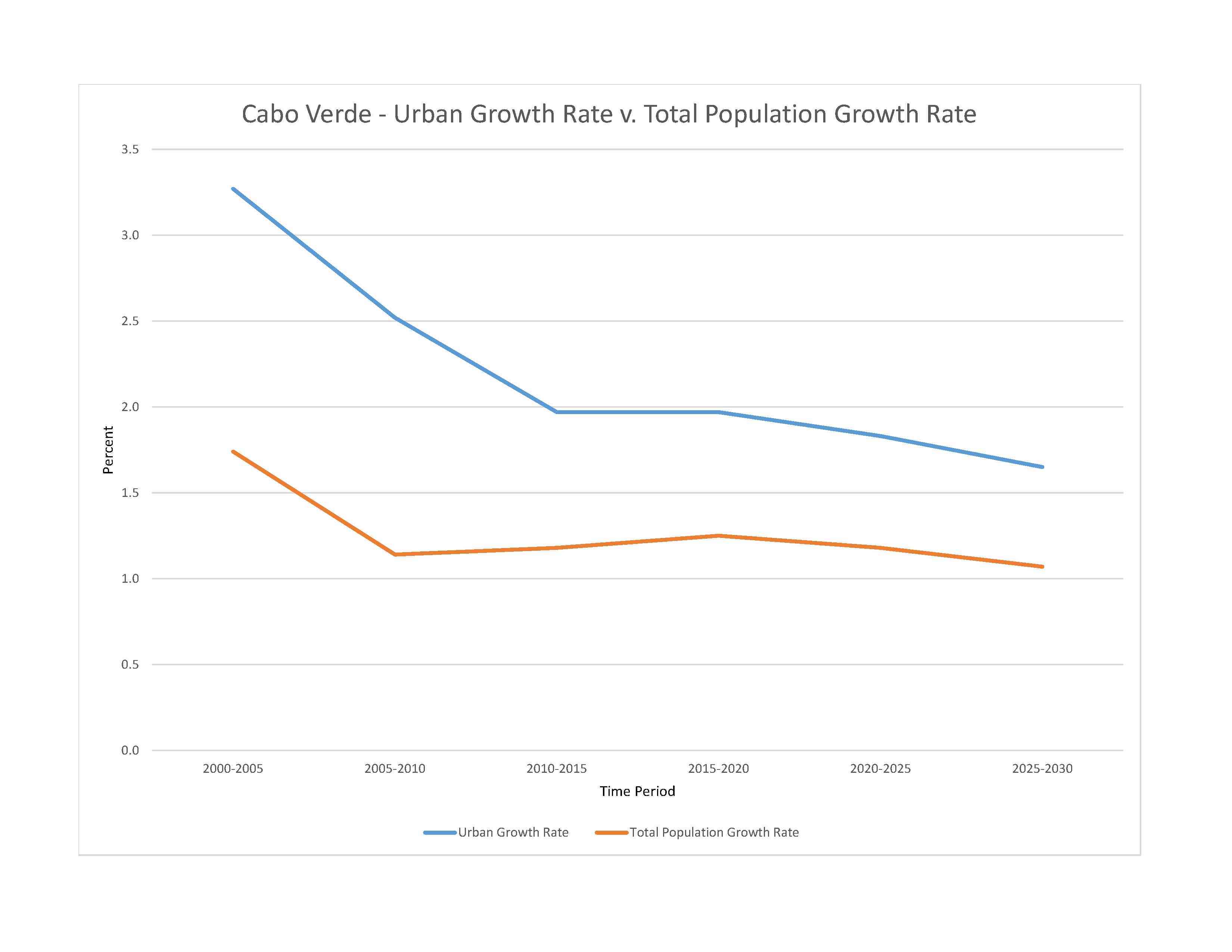
603,901 (2023 est.)
noun: Cabo Verdean(s)
adjective: Cabo Verdean
Creole (Mulatto) 71%, African 28%, European 1%
Portuguese (official), Crioulo (a Portuguese-based Creole language with two main dialects spoken in Cabo Verde and in the Cabo Verdean diaspora worldwide)
Roman Catholic 72.5%, Protestant 4% (includes Adventist 1.9%, Nazarene 1.8%, Assembly of God 0.2%, God is Love 0.1%), Christian Rationalism 1.7%, Muslim 1.3%, Jehovah's Witness 1.2%, Church of Jesus Christ 1%, other Christian 1.3%, other 1.2%, none 15.6%, no response 0.4% (2021 est.)
Cabo Verde’s population descends from its first permanent inhabitants in the late 15th-century – a preponderance of West African slaves, a small share of Portuguese colonists, and even fewer Italians, Spaniards, and Portuguese Jews. Over the centuries, the country’s overall population size has fluctuated significantly, as recurring periods of famine and epidemics have caused high death tolls and emigration.
Labor migration historically reduced Cabo Verde’s population growth and still provides a key source of income through remittances. Expatriates probably outnumber Cabo Verde’s resident population, with most families having a member abroad. Cabo Verdeans have settled in the US, Europe, Africa, and South America. The largest diaspora community in New Bedford, Massachusetts, dating to the early 1800s, is a byproduct of the transatlantic whaling industry. Cabo Verdean men fleeing poverty at home joined the crews of US whaling ships that stopped in the islands. Many settled in New Bedford and stayed in the whaling or shipping trade, worked in the textile or cranberry industries, or operated their own transatlantic packet ships that transported compatriots to the US. Increased Cabo Verdean emigration to the US coincided with the gradual and eventually complete abolition of slavery in the archipelago in 1878.
During the same period, Portuguese authorities coerced Cabo Verdeans to go to Sao Tome and Principe and other Portuguese colonies in Africa to work as indentured laborers on plantations. In the 1920s, when the US implemented immigration quotas, Cabo Verdean emigration shifted toward Portugal, West Africa (Senegal), and South America (Argentina). Growing numbers of Cabo Verdean labor migrants headed to Western Europe in the 1960s and 1970s. They filled unskilled jobs in Portugal, as many Portuguese sought out work opportunities in the more prosperous economies of northwest Europe. Cabo Verdeans eventually expanded their emigration to the Netherlands, where they worked in the shipping industry. Migration to the US resumed under relaxed migration laws. Cabo Verdean women also began migrating to southern Europe to become domestic workers, a trend that continues today and has shifted the gender balance of Cabo Verdean emigration.
Emigration has declined in more recent decades due to the adoption of more restrictive migration policies in destination countries. Reduced emigration along with a large youth population, decreased mortality rates, and increased life expectancies, has boosted population growth, putting further pressure on domestic employment and resources. In addition, Cabo Verde has attracted increasing numbers of migrants in recent decades, consisting primarily of people from West Africa, Portuguese-speaking African countries, Portugal, and China. Since the 1990s, some West African migrants have used Cabo Verde as a stepping stone for illegal migration to Europe.
0-14 years: 26.68% (male 80,974/female 80,143)
15-64 years: 67.18% (male 198,503/female 207,205)
65 years and over: 6.14% (2023 est.) (male 14,099/female 22,977)
total dependency ratio: 47.2
youth dependency ratio: 39.2
elderly dependency ratio: 8
potential support ratio: 12.5 (2021 est.)
total: 28.3 years (2023 est.)
male: 27.5 years
female: 29.2 years
1.19% (2023 est.)
18.2 births/1,000 population (2023 est.)
5.8 deaths/1,000 population (2023 est.)
-0.6 migrant(s)/1,000 population (2023 est.)
among the nine inhabited islands, population distribution is variable; islands in the east are very dry and are only sparsely settled to exploit their extensive salt deposits; the more southerly islands receive more precipitation and support larger populations, but agriculture and livestock grazing have damaged the soil fertility and vegetation; approximately half of the population lives on Sao Tiago Island, which is the location of the capital of Praia; Mindelo, on the northern island of Sao Vicente, also has a large urban population as shown in this 
urban population: 68% of total population (2023)
rate of urbanization: 1.83% annual rate of change (2020-25 est.)

168,000 PRAIA (capital) (2018)
at birth: 1.03 male(s)/female
0-14 years: 1.01 male(s)/female
15-64 years: 0.96 male(s)/female
65 years and over: 0.61 male(s)/female
total population: 0.95 male(s)/female (2023 est.)
42 deaths/100,000 live births (2020 est.)
total: 23 deaths/1,000 live births (2023 est.)
male: 27 deaths/1,000 live births
female: 18.8 deaths/1,000 live births
total population: 74 years (2023 est.)
male: 71.7 years
female: 76.4 years
2.11 children born/woman (2023 est.)
1.04 (2023 est.)
55.8% (2018)
improved: urban: 100% of population
rural: 90% of population
total: 96.7% of population
unimproved: urban: 0% of population
rural: 10% of population
total: 3.3% of population (2020 est.)
6% of GDP (2020)
0.83 physicians/1,000 population (2018)
2.1 beds/1,000 population
improved: urban: 91.7% of population
rural: 73.3% of population
total: 85.6% of population
unimproved: urban: 8.3% of population
rural: 26.7% of population
total: 14.4% of population (2020 est.)
11.8% (2016)
total: 4.7 liters of pure alcohol (2019 est.)
beer: 2.28 liters of pure alcohol (2019 est.)
wine: 1.82 liters of pure alcohol (2019 est.)
spirits: 0.6 liters of pure alcohol (2019 est.)
other alcohols: 0 liters of pure alcohol (2019 est.)
total: 11.4% (2020 est.)
male: 17.3% (2020 est.)
female: 5.4% (2020 est.)
N/A
46.9% (2023 est.)
7.6% of GDP (2020 est.)
definition: age 15 and over can read and write
total population: 90.8%
male: 94.2%
female: 87.4% (2021)
total: 13 years
male: 12 years
female: 13 years (2018)
NOTE: The information regarding Cabo Verde on this page is re-published from the 2024 World Fact Book of the United States Central Intelligence Agency and other sources. No claims are made regarding the accuracy of Cabo Verde 2024 information contained here. All suggestions for corrections of any errors about Cabo Verde 2024 should be addressed to the CIA or the source cited on each page.
This page was last modified 04 May 24, Copyright © 2024 ITA all rights reserved.